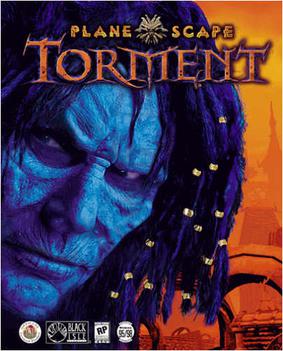
Planescape: Torment is a 1999 role-playing video game developed by Black Isle Studios and published by Interplay Entertainment for Windows. The game takes place in locations from the multiverse of Planescape, a Dungeons & Dragons (D&D) fantasy campaign setting. The game's engine is a modified version of the Infinity Engine, which was used for BioWare's Baldur's Gate, a previous D&D game set in the Forgotten Realms.
Wizardry is a series of role-playing video games, developed by Sir-Tech, that were highly influential in the evolution of modern role-playing video games. The original Wizardry was a significant influence on early console role-playing games such as Final Fantasy and Dragon Quest. Originally made for the Apple II, the games were later ported to other platforms. The last game in the original series by Sir-Tech was Wizardry 8, released in 2001. There have since been various spin-off titles developed for the Japanese market.

Icewind Dale is a role-playing video game developed by Black Isle Studios and originally published by Interplay Entertainment for Windows in 2000 and by MacPlay for the Macintosh in 2002. The game takes place in the Dungeons & Dragons Forgotten Realms campaign setting and the region of Icewind Dale, and uses the 2nd edition ruleset. The story follows a different set of events than those of R. A. Salvatore's The Icewind Dale Trilogy novels: in the game, an adventuring party becomes enlisted as a caravan guard while in Icewind Dale, in the wake of strange events, and eventually discover a plot that threatens the Ten Towns of Icewind Dale and beyond.

A role-playing video game, a role-playing game (RPG) or computer role-playing game (CRPG), is a video game genre where the player controls the actions of a character immersed in some well-defined world, usually involving some form of character development by way of recording statistics. Many role-playing video games have origins in tabletop role-playing games and use much of the same terminology, settings, and game mechanics. Other major similarities with pen-and-paper games include developed story-telling and narrative elements, player character development, complexity, as well as replay value and immersion. The electronic medium removes the necessity for a gamemaster and increases combat resolution speed. RPGs have evolved from simple text-based console-window games into visually rich 3D experiences.

Sir-Tech Software, Inc. was a video game developer and publisher based in the United States and Canada.

Dungeon Siege is an action role-playing game developed by Gas Powered Games and published by Microsoft in April 2002, for Microsoft Windows, and the following year by Destineer for Mac OS X. Set in the pseudo-medieval kingdom of Ehb, the high fantasy game follows a young farmer and her companions as they journey to defeat an invading force. Initially only seeking to warn the nearby town of the invasion of a race of creatures named the Krug, the farmer and the companions that join her along the way are soon swept up in finding a way to defeat another race called the Seck, resurgent after being trapped for 300 years. Unlike other role-playing video games of the time, the world of Dungeon Siege does not have levels but is a single, continuous area without loading screens that the player journeys through, fighting hordes of enemies. Also, rather than setting character classes and manually controlling all of the characters in the group, the player controls their overall tactics and weapons and magic usage, which direct their character growth.
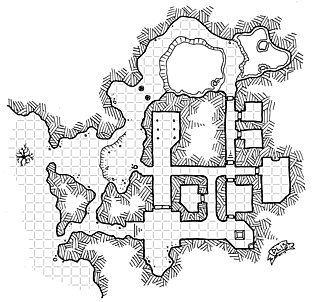
A dungeon crawl is a type of scenario in fantasy role-playing games (RPGs) in which heroes navigate a labyrinth environment, battling various monsters, avoiding traps, solving puzzles, and looting any treasure they may find. Video games and board games which predominantly feature dungeon crawl elements are considered to be a genre.
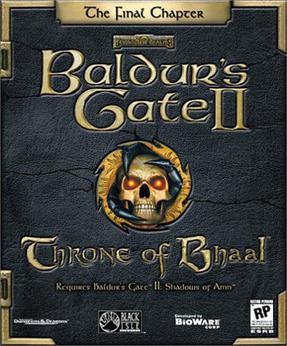
Baldur's Gate II: Throne of Bhaal is a 2001 expansion pack for the role-playing video game Baldur's Gate II: Shadows of Amn. It adds a multi-level dungeon called Watcher's Keep to the game and completes the main plot. There are several new weapons, a higher level cap, a further refined Infinity graphics engine, and new class-related features and magical skills. The novelization of the game was written by Drew Karpyshyn and released in September 2001.

Baldur's Gate II: Shadows of Amn is a role-playing video game developed by BioWare and published by Interplay Entertainment. It is the sequel to 1998's Baldur's Gate and was released for Microsoft Windows in September 2000. Following its predecessor, the game takes place in the Forgotten Realms, a fantasy campaign setting, and is based on the Advanced Dungeons & Dragons 2nd edition rules. Powered by BioWare's Infinity Engine, Baldur's Gate II uses an isometric perspective and pausable real-time gameplay. The player controls a party of up to six characters, one of whom is the player-created protagonist; the others are certain characters recruited from the game world.

Summoner is an action role-playing game developed by Volition and published by THQ. It was released as a launch title for the PlayStation 2 in 2000, and was subsequently ported to Microsoft Windows and Mac OS the following year. In the game, the player plays the role of Joseph and can assemble a team of compatriots and summon powerful monsters. The game has a world map, involved storyline, and unique hybrid combat system involving real-time and turn-based mechanisms.
An action role-playing game is a subgenre of video games that combines core elements from both the action game and role-playing genre.
David W. Bradley is a video game designer and programmer, most notable for the role-playing video games Wizardry V, VI, and VII.

Wizardry: Proving Grounds of the Mad Overlord is the first game in the Wizardry series of role-playing video games. It was developed by Andrew Greenberg and Robert Woodhead. In 1980, Norman Sirotek formed Sir-Tech Software, Inc. and launched a beta version of the product at the 1980 Boston Computer Convention. The final version of the game was released in 1981.

Wizardry VII: Crusaders of the Dark Savant is the seventh title in the Wizardry series of role-playing video games by Sir-Tech Software, Inc., preceding Wizardry 8 and succeeding Wizardry VI: Bane of the Cosmic Forge. It is also the second entry in the 'Dark Savant' trilogy. The game was published in 1992 by Sir-Tech, originally developed for DOS. In 1996 it was remade into Wizardry Gold, designed to work on Windows and Macintosh, and distributed by Interplay.
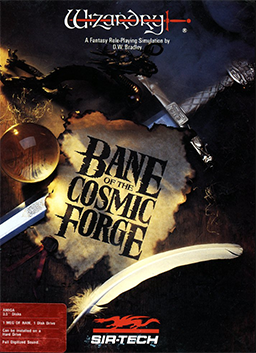
Wizardry VI: Bane of the Cosmic Forge is the 6th title in the Wizardry series of role-playing video games. It was the first in the trilogy surrounding the Dark Savant, which was followed by Wizardry VII: Crusaders of the Dark Savant and Wizardry 8. It was developed by Sir-Tech Software, Inc. and was released on the Amiga and DOS platforms in 1990 by the same company, and for the Super Famicom in Japan in 1995 by ASCII.
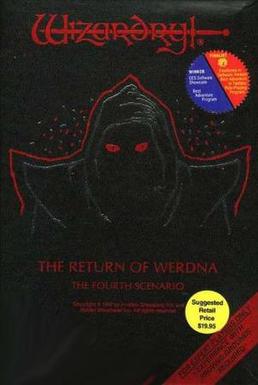
Wizardry IV: The Return of Werdna is the fourth scenario in the Wizardry series of role-playing video games. It was published in 1987 by Sir-Tech Software, Inc. It was later ported on home consoles, such as the PC Engine CD and the PlayStation, through the Wizardry: New Age of Llylgamyn compilation.

Baldur's Gate is a role-playing video game that was developed by BioWare and published in 1998 by Interplay Entertainment. It is the first game in the Baldur's Gate series and takes place in the Forgotten Realms, a high fantasy campaign setting, using a modified version of the Advanced Dungeons & Dragons (AD&D) 2nd edition rules. It was the first game to use the Infinity Engine for its graphics, with Interplay using the engine for other Forgotten Realms-licensed games, including the Icewind Dale series and Planescape: Torment. The game's story focuses on a player-made character who travels across the Sword Coast alongside a party of companions.
Western role-playing video games are role-playing video games developed in the Western world, including The Americas and Europe. They originated on mainframe university computer systems in the 1970s, were later popularized by titles such as Ultima and Wizardry in the early- to mid-1980s, and continue to be produced for modern home computer and video game console systems. The genre's "Golden Age" occurred in the mid- to late-1980s, and its popularity suffered a downturn in the mid-1990s as developers struggled to keep up with changing fashion, hardware evolution and increasing development costs. A later series of isometric role-playing games, published by Interplay Productions and Blizzard Entertainment, was developed over a longer time period and set new standards of production quality.

Nemesis: The Wizardry Adventure is a 1996 adventure and role-playing video game developed and published by Sir-Tech. It is a spin-off of the Wizardry series of games. Ports for Sega Saturn and Microsoft Windows were released in Japan in 1998.














